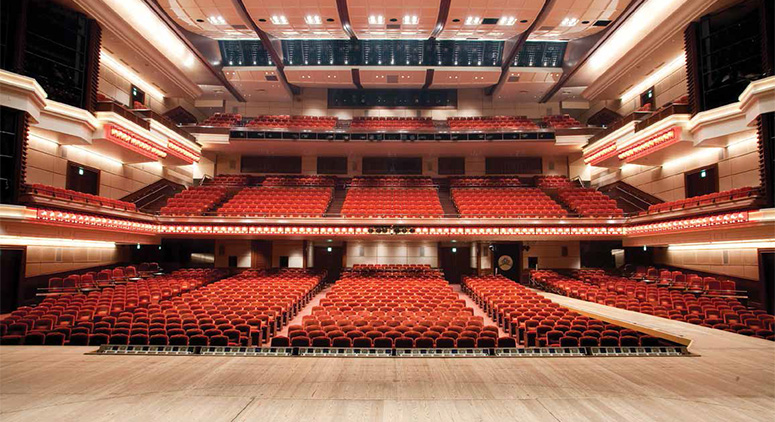The amplification’s the thing, Shakespeare’s Hamlet didn’t quite say. But, like a lot of dramatic types, he wanted to be heard. To achieve that goal has become a task with the complexity of that tragic Dane, as sound reinforcement technology continues to evolve. It doesn’t have to end in tragedy though, as a number of new audio offerings are solving problems almost as ancient as the live theater art form itself. Here are the production notes for new technology cast members that might appear on or in front of your stage soon.
1. A STAGE MANAGER FOR WIRELESS MICS
The use of wireless mics in theater applications is ubiquitous. The freedom they allow for performers to roam around the stage, through intricate sets, and between various costumes demands portability and reliability in microphone solutions. Unfortunately, the world’s theater capitals are located in some of the worst RF environments for wireless systems, which makes a full-time job of keeping tabs on wireless mics operations. “Whether it’s a microphone element that is starting to go, or RF interference on a certain frequency, technicians need to catch and resolve problems before they are noticed,” said Sam Drazin, product manager at Shure Incorporated. “With Timeline, a new feature in Shure Wireless Workbench 6, techs can monitor and inspect the health of their wireless audio channels over time. Timeline records and displays essential wireless parameters like RF/audio level, battery life and more, so that issues can be visually detected, preempted and fixed at the source. Technicians will spend less time troubleshooting, and more time resolving issues.” Timeline is supported by the following Shure wireless systems: Axient Wireless Management Network; UHF-R Wireless Systems; ULX-D Digital Wireless Systems; QLX-D Digital Wireless Systems; and the PSM1000 Personal Monitor System.
2. CONSIDER CASTING A 2.4GHZ CO-STAR
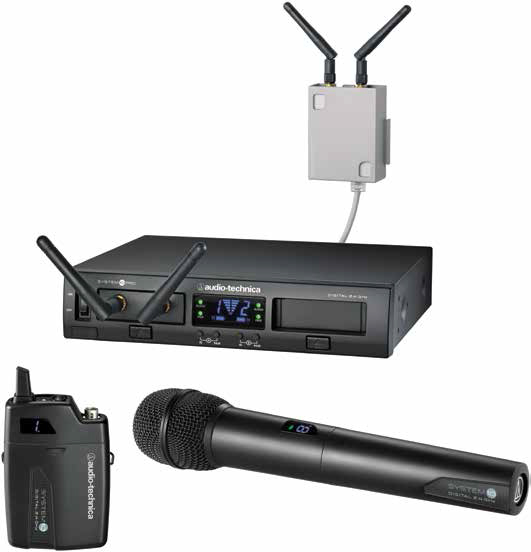
The Audio-Technica System 10 PRO Rack-Mount Digital Wireless System Alternatively, in larger systems where frequency availability and coordination can become a limiting factor for channel count, the Audio-Technica System 10 PRO can be a cost-effective solution. “Since the System 10 PRO operates in the 2.4GHz range, well outside TV interference and UHF wireless mics, users can add an additional 10 channels to an existing wireless installation that has been maxed-out, with no additional frequency coordination or interference,” explained Gary Boss, marketing director for professional markets at Audio-Technica. The System 10 PRO’s space-saving tendencies also extend to the hardware, as four channels fit in a single 19-inch rack space. And there’s no need for an antenna distribution system and remote antenna, because each channel of System 10 PRO has an ejectable receiver section (about the size of a deck of cards) can be remote-mounted up to 300 feet from the receiver chassis using category cable. When it’s all installed, Boss added, “Just turn on the transmitter, and it connects to the paired receiver and selects a clean frequency which is set on both the receiver and transmitter automatically. No user or operator intervention necessary.”
3. AVOID CORPORATE DRAMA WHEN THE EXECUTIVE TAKES THE MIC
Many times, in auditoriums and theaters on corporate campuses, presenters are required to mic themselves, which could lead to audio problems. “A standard cardioid lavalier can present a major challenge when trying to get consistent placement,” observed Eric Stahlhammer, business development/national sales support, DPA Microphones. “If the mic is placed further than expected from the mouth or if the capsule is rotated away from the speaker’s mouth, you can expect major issues with volume and tone. Ideally, a microphone should be simple to put on and be a simple design, so it can’t be put on improperly or broken easily. The DPA d:screet Necklace Microphone is a great solution because it has a simple jewelry clasp and an omnidirectional microphone. It cannot be pointed the wrong direction and the placement is consistent regardless if your presenter is wearing a dress, a t-shirt or no shirt at all. With the pre-engineered presence cap that sits over the microphone, the tone of the microphone is ready to go right out of the gate, keeping setup simple and foolproof.” The DPA d:screet Necklace Microphone is available in black, brown and white in two sizes and is compatible with virtually every wireless system.
4. THIS LINE ARRAY IS A CROWD PLEASER
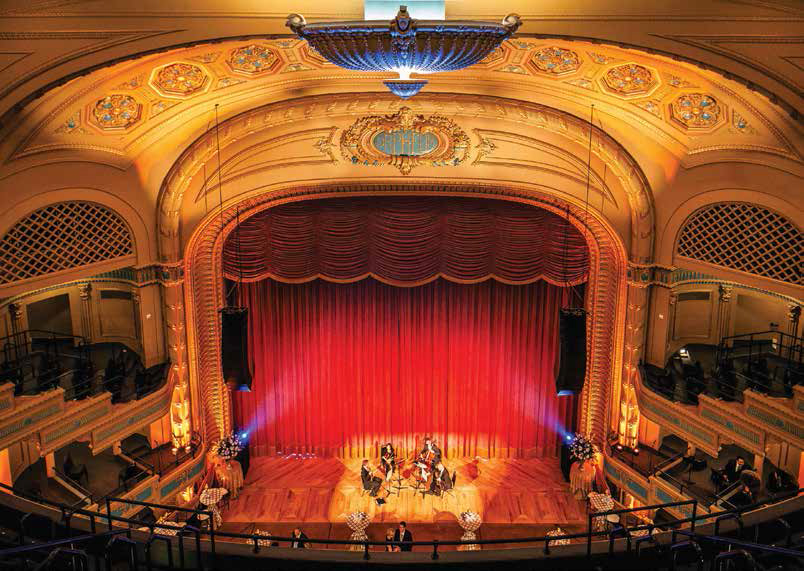
Originally built in 1918 and opened for vaudeville in 1921, the 1,500-seat RKO Orpheum Beaux Arts style theater has gone through several iterations. Now it’s equipped with Martin Audio. New line array offerings are offering wider coverage, which makes it possible to cover more seats with less gear. The advantages of the HARMAN JBL VTX and Crown I-Tech HD system really shine in applications like the Regent Theater in downtown Los Angeles, California. The setup provides a streamlined configuration that can be precisely fine-tuned with smart amplifiers. The Regent has a main floor that slopes to the stage and a newly built second-floor mezzanine level and the VTX arrays deliver wide, even, controlled coverage to both levels, eliminating the need to install separate speakers for the mezzanine. The Crown amplifiers also helped to simplify the system design, with the amplifier’s built-in processing and ability to be matched to the VTX arrays and the stage monitors saving the venue space that would otherwise be needed for loudspeaker management technology and outboard hardware.
5. A NEW WAY TO FIT DISTRIBUTED AUDIO INTO A SCENE
Many live theater events rely on a distributed system but that can mean a lot of speakers being placed in order to bring the necessary coverage, and with it expense and hassle. One of Martin Audio’s latest lines, CDD-LIVE! provides a new option. “CDD-LIVE! incorporates the patented technology of coaxial differential dispersion that combines the ‘point-source’ benefits of coaxial designs with the consistent coverage of differential dispersion,” said Lee Stein, VP at Martin Audio North America. “This projects sound evenly front-to-back while exhibiting wide horizontal coverage close to the speaker, delivering ultimate fidelity and impact to all corners of the audience while allowing speakers to be spaced further apart. Ultimately this means that fewer speakers are required which can impact positively on hardware cost and setup time. It also means fewer speakers to intrude on line of sight.”
6. ASSISTIVE LISTENING HAS A NEW STAR
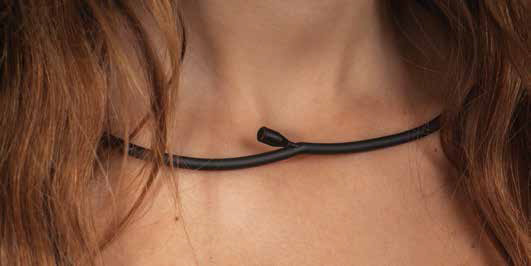
The DPA d:screet Necklace 4061 microphone For theaters with high ceilings, many columns and seats located in corners that make it difficult to provide reliable line-of-sight coverage with infrared assistive listening systems, FM wireless is another option. Responding to customer requests for just such an option, Media Vision designed a lightweight, easy-to-use and program, product that “solves problems for our customers while not breaking the budget,” noted Kevin Stoner, director of operations at Media Vision. “We believe that by providing a great solution at a reasonable cost, more facilities can offer assistive listening and therefore more of our population can feel comfortable attending a show.” In its development research, Media Vision identified key ALS system factors that make the job of facility managers easier, including programmability that is easily accomplished using a software interface and also on the units and custom channel labeling. Additionally, “some bonus features can be true life savers, such as the auto-off capability for extended battery life,” Stoner noted. “And accessories should not be overlooked. For instance, the Media Vision assistive listening earpieces and headphones were designed to be easy to clean. Our receiver has a removable belt clip, thus in case the clip breaks you do not have to replace the entire unit. Also, we offer flexible options for charging cases placement: in the carrying case, desktop, or even wall-mounted for easy product distribution.”
7. MAKE SURE ALS RECEIVES TOP BILLING
“While induction loop, infrared and radio frequency ALS are not new, not everyone is aware of these technologies or taking advantage of them to enhance their theater experience,” observed Maile Keone, chief revenue officer at Listen Technologies. To remedy this, “raise awareness of ALS and educate patrons about how to use them through advertising, signage and informed employees.” As as an example, Keone noted that when patrons of Hale Center Theatre in Utah inquire about seats near the stage, customer service representatives are trained to ask if the inquiry is because of hearing issues. Employees can educate patrons about ALS accordingly. As a result, Hale routinely checks out 20 to 40 receivers during every performance, providing a much better listening experience for their patrons.
Now there is one more option for theater operators to offer, an ALS offering that uses Wi-Fi to deliver audio from the stage to a user’s smartphone. This technology does not meet compliancy regulations under the ADA, but it allows venues to offer patrons another ALS option. One such offering is Listen Technologies’ ListenWiFi. Patrons download a free app on their mobile device, connect to the WiFi network and tune to the channel that is broadcasting audio from the stage.
8. KNOW YOUR ALS AUDIENCE
Along with these new Wi-Fi options, which include Williams Sound’s Hearing HotSpot, comes an added responsibility, noted Paul Ingebrigtsen, president and CEO of Williams Sound, that of managing users in addition to equipment. This includes helping patrons to download an app, dealing with compatibility issues and hoping audience members can resist the temptation to use their mobile phone for more distracting purposes other than ALS during the performance. Additionally, he added that to truly meet ADA requirements, theaters need to have some community-use devices available for use with the Wi-Fi system, that means the purchase of extra iPods or Android devices. Whether a theater operator chooses infrared, FM, hearing loop or a Wi-FI based option, in the end the choice for the most suitable ALS technology comes down to the audience. “Will their users be happy with the system, and will they use the system?” Ingebrigtsen asked. Each ALS technology has its pluses and minuses, he said, “and the choice comes down to which one is going to be the best fit for a given facility and the types of clients they have and to some extent to how much management is the facility willing and able to do.”Kirsten Nelson is a regular contributor to AV Technology and SCN's editor-at-large.
Roland Ships VR-4HD High-Definition AV Mixer in December
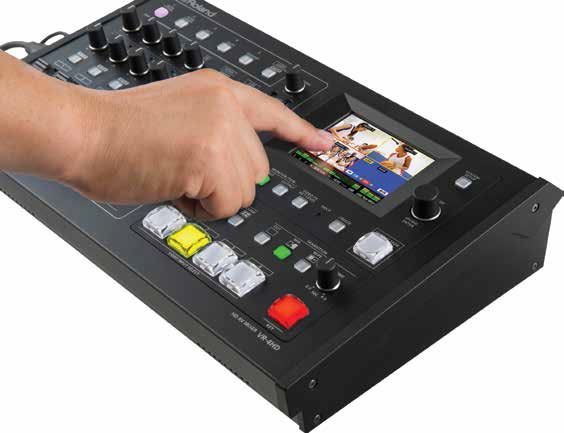
The What: Roland is now shipping its VR-4HD High-Definition AV Mixer, an easy-to-use, compact and portable AV Mixer that integrates a digital audio mixer, video switcher, multi-viewer touch screen and USB video/audio streaming interface into a stand-alone device.
The Why: “The VR-4HD is a portable live HD production solution ideal for schools, churches, council meetings, corporate events, sports, training, or any other live event,” said Christian Delfino, Vice President of Product Management for the Roland Professional A/V Division. “Whether being used to produce an online broadcast, support a presentation or even as the hub for a multi-input teleconference system using standard online chat software, the VR-4HD’s all-in-one hardware design and audio digital signal processing capabilities, including Auto-Mixing function, make it easy for a single operator to achieve professional results.”
The What Else: The VR-4HD has three dedicated HDMI input connectors compatible with a variety of equipment and offering support for 1080p/1080i/720p video resolutions. A fourth input includes a scaler to support both video and computer resolutions and also supports analog RGB and component input, as well as HDMI, so older devices can be used as sources without the need for external conversion equipment. HDCP is supported for input of copy-protected content from devices such as Blu-ray disc players. The Loop Back? A unique loop-back audio capability via the USB 3.0 port can bring in audio from a connected PC using a conferencing software such as Skype and return audio to the PC without any audio feedback thanks to the included Echo Cancellation feature. This makes the VR-4HD an ideal web conferencing tool that allows for multiple video and audio sources to be used with online web conference software.
Bottom Line: Recording or webcasting from the VR-4HD is easily achieved by connecting to a PC or Mac using the built-in USB 3.0 connection. Up to Full 1080/30p uncompressed resolution video can be outputted from the VR-4HD. The VR-4HD embeds the audio mix with the video program and delivers it at the selected resolution. Included VR Video Capture application for Mac and PC provides an easy and effective way to capture uncompressed video with high-resolution audio. The VR Video Capture application can also capture compressed video for easy and immediate delivery of content to online video sites or internal corporate servers.
More Info: http://proav.roland.com/products/vr-4hd
AUDIO-TECHNICA
http://www.audio-technica.com/
DPA
http://www.dpamicrophones.com/
HARMAN
http://pro.harman.com/
LISTEN TECHNOLOGIES
https://www.listentech.com/
MARTIN AUDIO
https://martin-audio.com/
MEDIA VISION
http://www.media-vision.com/en/
SHURE INCORPORATED
http://www.shure.com/
WILLIAMS SOUND
https://www.williamssound.com/
